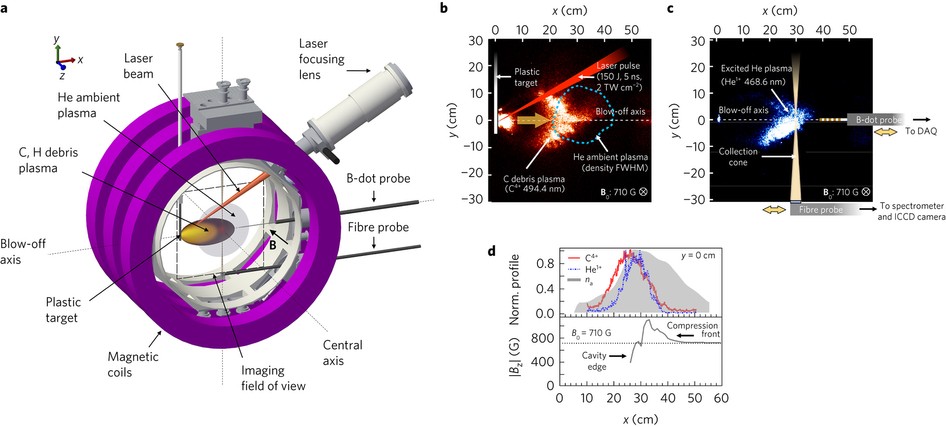dx.doi.org/10.1038/nphys4041
Preview meta tags from the dx.doi.org website.
Linked Hostnames
31- 60 links todx.doi.org
- 30 links toscholar.google.com
- 29 links toadsabs.harvard.edu
- 29 links todoi.org
- 24 links towww.nature.com
- 11 links toscholar.google.co.uk
- 11 links towww.ncbi.nlm.nih.gov
- 8 links towww.springernature.com
Thumbnail

Search Engine Appearance
Collisionless momentum transfer in space and astrophysical explosions - Nature Physics
Larmor coupling is a collisionless momentum exchange mechanism believed to occur in various astrophysical and space-plasma environments. The phenomenon is now observed in a laboratory experiment. The AMPTE (Active Magnetospheric Particle Tracer Explorers) mission provided in situ measurements of collisionless momentum and energy exchange between an artificial, photo-ionized barium plasma cloud and the streaming, magnetized hydrogen plasma of the solar wind 1,2,3. One of its most significant findings was the unanticipated displacement of the barium ion ‘comet head’ (and an oppositely directed deflection of the streaming hydrogen ions) transverse to both the solar wind flow and the interplanetary magnetic field, defying the conventional expectation that the barium ions would simply move downwind4. While subsequent theoretical and computational efforts5,6,7 to understand the cause of the transverse motion reached differing conclusions, several authors5 attributed the observations to Larmor coupling8,9, a collisionless momentum exchange mechanism believed to occur in various astrophysical and space-plasma environments10,11 and to participate in cosmic magnetized collisionless shock formation12,13,14. Here we present the detection of Larmor coupling in a reproducible laboratory experiment that combines an explosive laser-produced plasma cloud with preformed, magnetized ambient plasma in a parameter regime relevant to the AMPTE barium releases. In our experiment, time-resolved Doppler spectroscopy reveals ambient ion acceleration transverse to both the laser-produced plasma flow and the background magnetic field. Utilizing a detailed numerical simulation, we demonstrate that the ambient ion velocity distribution corresponding to the measured Doppler-shifted spectrum is qualitatively and quantitatively consistent with Larmor coupling.
Bing
Collisionless momentum transfer in space and astrophysical explosions - Nature Physics
Larmor coupling is a collisionless momentum exchange mechanism believed to occur in various astrophysical and space-plasma environments. The phenomenon is now observed in a laboratory experiment. The AMPTE (Active Magnetospheric Particle Tracer Explorers) mission provided in situ measurements of collisionless momentum and energy exchange between an artificial, photo-ionized barium plasma cloud and the streaming, magnetized hydrogen plasma of the solar wind 1,2,3. One of its most significant findings was the unanticipated displacement of the barium ion ‘comet head’ (and an oppositely directed deflection of the streaming hydrogen ions) transverse to both the solar wind flow and the interplanetary magnetic field, defying the conventional expectation that the barium ions would simply move downwind4. While subsequent theoretical and computational efforts5,6,7 to understand the cause of the transverse motion reached differing conclusions, several authors5 attributed the observations to Larmor coupling8,9, a collisionless momentum exchange mechanism believed to occur in various astrophysical and space-plasma environments10,11 and to participate in cosmic magnetized collisionless shock formation12,13,14. Here we present the detection of Larmor coupling in a reproducible laboratory experiment that combines an explosive laser-produced plasma cloud with preformed, magnetized ambient plasma in a parameter regime relevant to the AMPTE barium releases. In our experiment, time-resolved Doppler spectroscopy reveals ambient ion acceleration transverse to both the laser-produced plasma flow and the background magnetic field. Utilizing a detailed numerical simulation, we demonstrate that the ambient ion velocity distribution corresponding to the measured Doppler-shifted spectrum is qualitatively and quantitatively consistent with Larmor coupling.
DuckDuckGo
Collisionless momentum transfer in space and astrophysical explosions - Nature Physics
Larmor coupling is a collisionless momentum exchange mechanism believed to occur in various astrophysical and space-plasma environments. The phenomenon is now observed in a laboratory experiment. The AMPTE (Active Magnetospheric Particle Tracer Explorers) mission provided in situ measurements of collisionless momentum and energy exchange between an artificial, photo-ionized barium plasma cloud and the streaming, magnetized hydrogen plasma of the solar wind 1,2,3. One of its most significant findings was the unanticipated displacement of the barium ion ‘comet head’ (and an oppositely directed deflection of the streaming hydrogen ions) transverse to both the solar wind flow and the interplanetary magnetic field, defying the conventional expectation that the barium ions would simply move downwind4. While subsequent theoretical and computational efforts5,6,7 to understand the cause of the transverse motion reached differing conclusions, several authors5 attributed the observations to Larmor coupling8,9, a collisionless momentum exchange mechanism believed to occur in various astrophysical and space-plasma environments10,11 and to participate in cosmic magnetized collisionless shock formation12,13,14. Here we present the detection of Larmor coupling in a reproducible laboratory experiment that combines an explosive laser-produced plasma cloud with preformed, magnetized ambient plasma in a parameter regime relevant to the AMPTE barium releases. In our experiment, time-resolved Doppler spectroscopy reveals ambient ion acceleration transverse to both the laser-produced plasma flow and the background magnetic field. Utilizing a detailed numerical simulation, we demonstrate that the ambient ion velocity distribution corresponding to the measured Doppler-shifted spectrum is qualitatively and quantitatively consistent with Larmor coupling.
General Meta Tags
125- titleCollisionless momentum transfer in space and astrophysical explosions | Nature Physics
- titleClose banner
- titleClose banner
- X-UA-CompatibleIE=edge
- applicable-devicepc,mobile
Open Graph Meta Tags
6- og:urlhttps://www.nature.com/articles/nphys4041
- og:typearticle
- og:site_nameNature
- og:titleCollisionless momentum transfer in space and astrophysical explosions - Nature Physics
- og:descriptionLarmor coupling is a collisionless momentum exchange mechanism believed to occur in various astrophysical and space-plasma environments. The phenomenon is now observed in a laboratory experiment.
Twitter Meta Tags
6- twitter:site@NaturePhysics
- twitter:cardsummary_large_image
- twitter:image:altContent cover image
- twitter:titleCollisionless momentum transfer in space and astrophysical explosions
- twitter:descriptionNature Physics - Larmor coupling is a collisionless momentum exchange mechanism believed to occur in various astrophysical and space-plasma environments. The phenomenon is now observed in a...
Item Prop Meta Tags
5- position1
- position2
- position3
- position4
- publisherSpringer Nature
Link Tags
15- alternatehttps://www.nature.com/nphys.rss
- apple-touch-icon/static/images/favicons/nature/apple-touch-icon-f39cb19454.png
- canonicalhttps://www.nature.com/articles/nphys4041
- icon/static/images/favicons/nature/favicon-48x48-b52890008c.png
- icon/static/images/favicons/nature/favicon-32x32-3fe59ece92.png
Emails
1Links
237- http://adsabs.harvard.edu/cgi-bin/nph-data_query?link_type=ABSTRACT&bibcode=1971PhFl...14..849P
- http://adsabs.harvard.edu/cgi-bin/nph-data_query?link_type=ABSTRACT&bibcode=1971PhFl...14.1905W
- http://adsabs.harvard.edu/cgi-bin/nph-data_query?link_type=ABSTRACT&bibcode=1972PhFl...15.2367M
- http://adsabs.harvard.edu/cgi-bin/nph-data_query?link_type=ABSTRACT&bibcode=1977SSRv...20..145M
- http://adsabs.harvard.edu/cgi-bin/nph-data_query?link_type=ABSTRACT&bibcode=1978JAMTP..19..602G